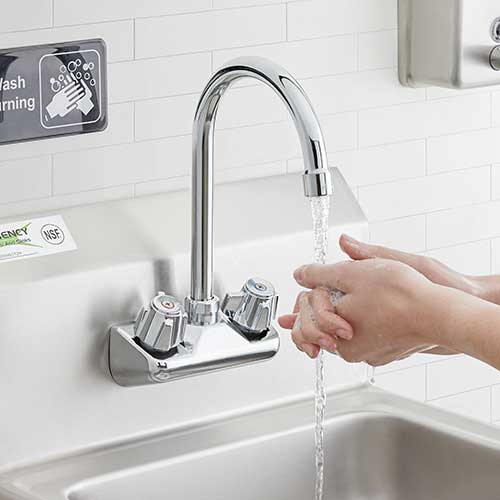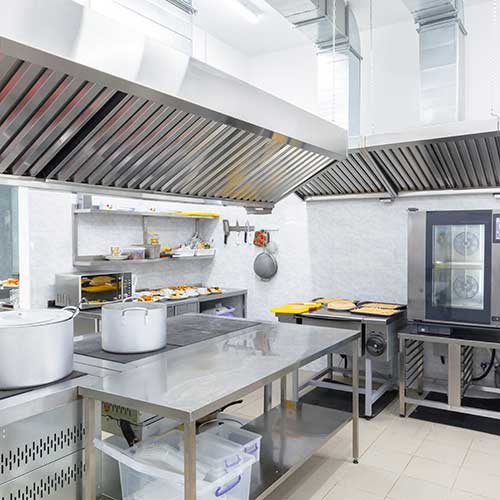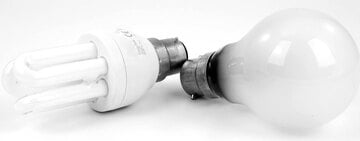
Reducing your restaurant's overall energy consumption not only lowers your utility costs, it's also better for the environment. Many food service professionals have been adopting energy conservation methods for the past decade and have drastically cut their energy use and expenses. Here, we've outlined energy conservation tips that will reduce your water and electricity use.
10 Energy Conservation Methods
It can be easier than you think to reduce energy consumption in your kitchen with our energy-saving methods! Here are our top 10 tips for conserving energy in your business.
1. Use Energy Efficient Equipment

Commercial equipment contributes a great deal to your restaurant's energy consumption, but your restaurant equipment doesn't have to guzzle resources. Many manufacturers offer equipment that uses a fraction of the energy of their other models, and switching to those designs could save your business thousands of dollars per year.
- High-Efficiency Fryers - Upgrading your deep fryer to an energy-efficient model will not only save you money on utilities, but it will save you money on fryer oil as well. New high-efficiency fryer models experience less scorching which extends the life of your oil.
- High-Efficiency Dish Machines - Using an Energy Star certified dish machine can save an average of $1,500 annually when compared to a standard model.
- Energy Star Rebates - Not only does Energy Star certified equipment use much less energy than standard equipment, but it might also qualify you for a rebate. Incentives and rebates vary depending on your location, so make sure to check the Energy Star website.
2. Perform Equipment Maintenance
If you don't keep your equipment clean or service it regularly, it's probably working harder than it needs to be. There are a few simple preventative tasks you can perform on your own to increase your energy savings and extend the life of your equipment.
- Refrigerator Condenser Coils - The condenser coils on your refrigeration units become clogged with dust over time, which insulates the coils and prevents them from expelling heat. The result is that your unit has to work much harder to reach food-safe temperatures. Keeping your coils clean provides a major boost to the efficiency of your unit.
- Water Filters - Water filtration systems prevent calcification and mineral deposits in any equipment that connects to a water line. By replacing your water filters at the appropriate time, you ensure that scale buildup doesn't clog the internal components of your equipment and affect the efficiency of the unit.
3. Reduce Water Consumption

Restaurants require large amounts of water to sustain operations. Thankfully, there are some simple ways to reduce water consumption in your restaurant and lower your water bill.
- Use Low-Flow Spray Valves - Replace your pre-rinse spray valves with newer models that have lower GPM (gallons per minute) ratings. These low-flow spray valves are easy to replace and use much less water than older spray valves.
- Install Low-Flow Aerators - Your hand-washing sinks don't need to have a high GPM flow rating. Consider using low-flow aerators or flow regulators that limit the amount of water flowing out of the faucet and lower the GPM to save you money.
- Repair Leaky Faucets - Over time, the drips from a single leaky faucet add up. Instead of wasting water and money, repair your faucets with new components. Many new faucet parts feature a cartridge design so you can swap them out quickly without calling a plumber.
4. Use Energy-Efficient Lighting
By switching out incandescent light bulbs with energy-efficient lighting, you can drastically lower your lighting electricity costs. Not only will you save on your utility costs, but you'll also help the environment by conserving energy and lowering greenhouse emissions.
- LED Bulbs - LED bulbs use less electricity and last up to 10 times longer than a standard incandescent bulb.
- CFL Bulbs - Not quite as energy efficient as LEDs, CFL bulbs are still 4 times more efficient than standard incandescent bulbs. They produce more light than LEDs so they work well to light up large areas in your restaurant.
5. Decrease Heat Usage
Look for little ways to decrease the heat usage in your restaurant like using less hot water or preventing your employees from making changes to the temperature settings on your thermostat.
- Invest in a Smart Thermostat - Smart thermostats can be programmed remotely to optimize energy use. Many are also tamper-resistant to prevent unauthorized adjustments.
- Lower Water Temps on Your Dish Machine - Mandatory dishwashing temperatures in the food service industry are around 140 degrees Fahrenheit, according to the NRA. Double-check the requirements for your area, then optimize your water temperature so you don't use water that's hotter than it needs to be.
- Unheated Hand Dryers - Energy-efficient hand dryers that rely on forced air instead of heated air can use up to 80% less energy than a standard hand dryer.
Back to Top
6. Reduce Ambient Temperatures in Your Kitchen
When the ambient temperatures in your kitchen are too high, your refrigeration equipment works extra hard to keep foods chilled. By keeping ambient heat to a minimum, you can ensure the most efficient operation of your reach-ins and coolers.
- Use Induction Equipment - Induction cooking equipment works without the use of a flame or burner. They transfer heat directly to your cookware while the surrounding air stays cool.
- Kitchen Exhaust Hoods - Use condensate hoods above your dish machines and steam equipment to help remove hot air from your kitchen.
- Use LEDs - Make sure to use LED lightbulbs in your kitchen and prep areas because they don't emit as much heat as incandescent bulbs.
7. Shut Down Idle Equipment
Conserving energy can be as easy as turning off a light switch. This may sound simple, but countless restaurants waste hundreds of dollars a month because they leave idle equipment running.
- Use a Startup/Shutdown Schedule - Take the time to observe when your equipment units are being used the most and create a schedule for starting up and shutting down. During downtime, turn off the range or the fryer and begin preheating again when business picks up.
- Lighting Timers - Use timers for your outdoor lighting, or even try solar-powered outdoor lights that can charge themselves.
- Smart Controls - Investing in equipment with smart control technology allows you to start up your appliances remotely.
8. Make Your Kitchen Layout More Efficient

The layout of your kitchen can directly affect the efficiency of your equipment. There are a couple of basic rules to keep in mind that will ensure your appliances are operating at peak performance.
- Breathing Space - Your refrigeration equipment needs room to breathe and expel hot air as part of the cooling process. Without proper ventilation space around the unit, it uses more energy to stay cool.
- Separate Heating and Cooling Equipment - If you place your oven next to your ice machine, the ambient air will be hotter and the ice machine won't operate efficiently.
9. Train Staff to Follow Energy-Efficient Protocols
Besides buying energy-efficient equipment, cutting your costs rests on your shoulders and those of your staff members. To be successful with your new plan, your team must understand your guidelines.
- Outline Your Protocol - Make sure to highlight your energy-saving protocols in your employee handbook and all training sessions with new employees to get them started on the right foot.
- Post Reminders - Without a visual queue, it can be hard to remember every guideline. Post reminders above your sink, next to your light switches, and anywhere else in your kitchen that will help your employees follow your protocols.
10. Contact Your Utility Company
If you've followed all of the previous steps and you're still not seeing any effect on your utility bills, try contacting your utility company directly. They can provide you with an assessment of how much energy you use, as well as how much it's costing you. Once you have that information, you can set realistic goals for your business and begin implementing a serious energy conservation plan.
Back to TopWhile some restaurant owners may see energy conservation as an obstacle or a nuisance, the benefits of going green include lower expenses, a market for earth-loving customers, and a positive feeling about giving back to the environment. There are many things about owning a business that you probably can't control, like the cost of your location, your water and electricity provider, or your utility expenses. Nevertheless, you can control your usage of heat, lighting, and water to an extent. By using these tips, you'll start to see measurable benefits that will help your restaurant reduce waste and save money. Earth-conscious customers will appreciate your dedication to conserving energy, and the environment will, too!





